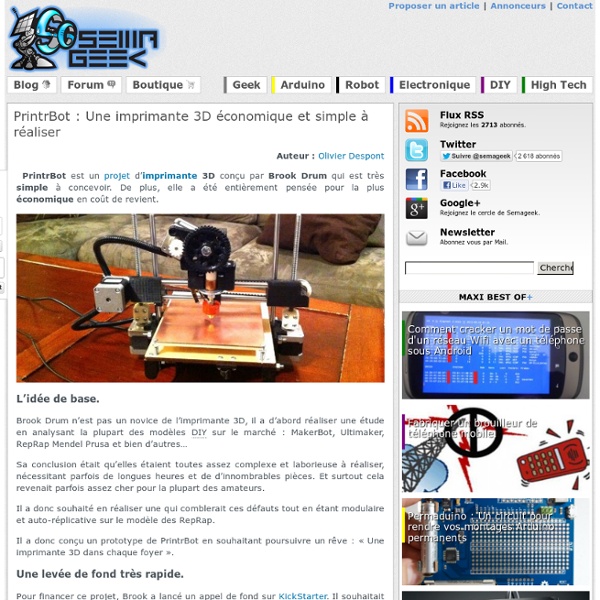Pour commencer
Électronique & logiciels Si vous désirez vous lancer dans l’aventure de la RepRap, je décris dans ce site un ensemble électronique et logiciel pouvant fonctionner sur n’importe quelle machine (Mendel, Prusa, Mendel Max, ReprapPro, Morgan, Huxley, etc.
3Doodler : Un stylo pour dessiner ( ou imprimer ) en 3D
3Doodler est un stylo qui va vous permettre de dessiner en 3 dimensions. Conçu sur le même principe que la tête d’impression d’une imprimante 3D, ce stylo utilise de l’ABS qui est chauffé et expulsé par une buse. Au contact de l’air ambiant, l’ABS se refroidit et se solidifie. Il est ainsi possible de réaliser à main-levée des structures tri-dimensionnelles solides et stables.
Mendel User Manual: Host Software
edit is restricted to the autoconfirmed group (set from the "protect" tab)move is restricted to the autoconfirmed group (set from the "protect" tab) This page has been flagged as containing duplicate material. An editor has suggested merging this page or section into DriverSoftware. (Discuss)
PrintrBot : Les plans sont disponibles sur Thingiverse
Il y a quelque temps, je vous ai présenté le projet PrintrBot, un imprimante 3D économique et simple à réaliser. Comme l’avait promis Brook Drum, son concepteur, il vient de mettre à disposition les plans de chaque pièce sur Thingiverse. Cela est une bonne occasion pour rendre cette imprimante totalement réplicative, mais c’est aussi un moyen pour réaliser la votre facilement si vous disposer déjà d’une autre imprimante 3D, ou si vous connaissez quelqu’un qui pourra réaliser les pièces pour vous. Vous pouvez donc retrouver toutes les fichiers 3D de chaque pièce au format STL sur Thingiverse.
Options
This page attempts to make some sense, in general, of how all the pieces fit together to create a RepRap. However, if you want to skip all this stuff and get straight to getting your hands dirty then your best bet is to take a look at The incomplete RepRap beginner's guide and the build instructions category. In addition to those guides, you may also want to take a look at the links under the Models section below.
Hot Glue Gun Extruder for Your CNC Machine or 3D Printer
3D Printing still costs a few dollars and may be out of reach of hobbiest who do not have any budget. The goal of this instructable is to construct an FDM (Fused Deposition Modeling) printer extruder (a key component) using a $3 Hot Glue Gun. If you don't think you have seen an FDM machine, you probably have.
Reprap Prusa I3 Rework Black Arcylic Frame Full 3D Printer Complete KIT Ramp 1 4
j h min
Introduction to 3D Printing
While all 3D printers create objects using additive methods (the opposite of a CNC machine), different approaches exist to actually physically depositing the material. The most common methods are: -Fused Deposition Modeling- A very common method in which the part is printed by extruding molten stings of material that melt together to create the part. This is usually the cheapest method, but quality can suffer, and materials are limited. Examples include: Maker Bot, RepRap, Objet, Cube, Solidoodle, Dimension and many others.



